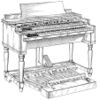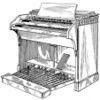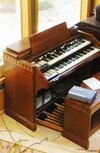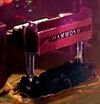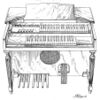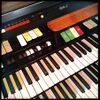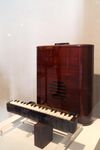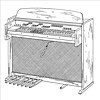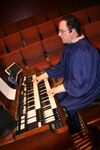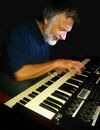Engineering:List of Hammond organs
The Hammond organ is an electric organ, invented by Laurens Hammond and John M. Hanert[1] and first manufactured in 1935.[2] Various models were produced, which originally used tonewheels to generate sound via additive synthesis, where component waveform ratios are mixed by sliding switches called drawbars and imitate the pipe organ's registers. Around 2 million Hammond organs have been manufactured, and it has been described as one of the most successful organs ever.[3] The organ is commonly used with, and associated with, the Leslie speaker.
Tonewheel organs
Tonewheel organs generate sound by shaped mechanical wheels, that rotate in front of electromagnetic pickups. Each tonewheel assembly creates tones with low harmonic content, close to a sine wave. Inside the coil is a permanent magnet. As the profile of the tonewheel pass by, the strength of the magnetism changes—when the highest part is closest to the tip of the magnet, the magnetism is strongest. As the magnetism varies, that induces an alternating current (AC) in the coil, which becomes one of the frequencies used in harmonic synthesis.[4]
| Image | Model Name / Number | Years produced | Description |
|---|---|---|---|
| File:Hammond Organ - Model A Medley.ogg | A | 1935–1938[5] | The first Hammond in production. Two 61-note manuals, 25-note pedalboard, 2 x 9 drawbars per manual, 2 pedal drawbars, 9 presets per manual, a tremolo effect generator ("tremulant").[5] |
| A-B | 1936–1938[5] /1942[6] | After the introduction of Model B-C in 1936, previous Model A was available as Model A-B.[5] / B series actually starts with Model A-B.[6] | |
| B-C | 1936–1942[7] | The first organ produced in the deeper Model B cabinet, to accommodate the chorus generator[7] | |
| B-A | 1938[8] | Model B-C style organ with built-in player organ mechanism[9] (possibly Duo-Art), custom built by Aeolian-Skinner.[10] | |
| BV | 1946–1949[6] | Same as Model B-C but with the Hammond Vibrato and Vibrato Chorus. Model B-C itself could be converted to the Model BCV by installing these units.[6] | |
| B-2 | 1949–1954[11] | Model B style cabinet with Selective Vibrato (vibrato available on either manual independently). | |
| B-3 | 1954–1974[12] | The best known Hammond. Similar to the B-2, but with added Touch-Response Percussion Control. Made famous by Jimmy Smith who influenced numerous other players.[13] | |
| A-100 | 1959–1965[14] | Same tone-wheel generator as the B-3 / C-3 but with power amp and speakers built into the console, along with a separate Reverb amplifier and speaker.[15] | |
| C | 1939–1942[16] | Almost same as Model A-B but with church style cabinet.[16] | |
| CV | 1945–1949[17] | Based on Model C, Hammond Vibrato was added. Similar to the B-V, but without a chorus generator, and with in a church style cabinetry.[17] | |
| C-2 | 1949–1954[11] | Identical to the B-2 except for cabinetry (Tudor-style "closed" cabinet). | |
| C-3 | 1954–1974[12] | The second best known Hammond. Identical to the B-3 except for cabinetry. | |
| D | 1939–1942[8] | A model C organ with factory supplied chorus generator | |
| D-100 | 1963–1969[18] | Internals of an RT-3 with built-in amp and speakers | |
| E | 1937–1949[19] | The first Hammond Organ with a 32-note American Guild of Organists (AGO) pedalboard. Also included toe pistons, a Great to Pedal coupler and separate Expression Pedals for Swell and Great Manuals. | |
| E-100 | 1965–1970[20] | A self-contained organ somewhat similar to the A-100 except for: One set of Drawbars per manual instead of two, Preset Tabs replace reverse-color Preset Keys, Percussion Voices with Reiterate instead of harmonic percussion and added Harp Sustain and rhythm effects (Cymbal and Brush) for Lower Manual and Pedals. | |
| E-200 | 1965–1971[21] | A version of the E-100 specifically designed for churches. Liturgical Preset Tabs, no Cymbal/Brush or Reiterate on the Percussion which plays from the Lower Manual. | |
| E-300 | 1965–1969[22] | A lower-cost version of the E-100. Celesta substituted for Harp Sustain in the Percussion section. | |
| G | 1941–1944[23] /1946[citation needed] | Almost identical to model D, except for the side handles for transportation. Model G means US Government model to use on US Army and various recreational service facilities. Supplied with tone cabinet G-40 (B-40 with an extra reverb unit).[23][24]
Two models in Church-styled cabinet were made under military specifications, and named G (G for "Government contract", with chorus), and G-2 (with vibrato), to be installed in chapels and officer's messes of U.S. Army and Navy.[citation needed] Later, Government model was taken over by model C-2G (1952-1953) and C-3G (1955-?).[23] | |
| G-100 | 1964–1967[25] | Non-drawbar tone-wheel organ built completely to AGO specifications. Included 65 stop tablets, 12 couplers, 18 thumb pistons, 8 toe pistons. Also known as the Grand-100. | |
| H-100 | 1965–1969[26] | Deluxe self-contained tone-wheel organ with extra tonewheels for higher pitched tones. Also included reverse-color Preset Keys, Mixture Drawbars for additional harmonic, String Bass (pedal sustain), Stereo Reverb and stereo chorus and vibrato scanners. 50 Watts of three-channel amplification.[27] | |
| H-262 | 1969–1975[28] | Version of the H-100 designed for churches. | |
| HX-100 | Version of the H-100 in an X-66-style case for stage work. Supplied with D10 speaker.[citation needed] | ||
| L-100 series | 1961–1968[19] | First Hammond to retail for under £1,000.[29]
| |
| Porta B series |
1971–1974[30] (1970[31]) | Portable version of L-100 series for professional use.[31] There were several versions on each country, built by different factories:[32]
| |
| M | 1948–51[11][33] | First spinet organ. 2x44 key manuals, 12 note pedalboard. | |
| M-2 | 1951–1955[11][33] | An M with Selective Vibrato (Vibrato available on either Manual separately). | |
| M-3 | 1955–1964[11][33] | Same as M-2 but with Touch-Response Percussion Control. | |
| M-100 | 1961–1968[34] | Tone-wheel spinet organ, replacing the M series. Added features include Presets, Vibrato Celeste and Stereo Reverb. Also the Legato Pedal control is controlled by a tablet, replacing the foot switch on the M-series organs. | |
| R-100 | 1970–1975[35] | Self-contained organ based on the E-100 but with transistor / solid-state power amp, built-in Leslie (no scanner vibrato) and Pedal String Bass. | |
| RT | 1949 | Replacement for the Model E. Similar cabinet style to models C and D but with 32 note AGO pedalboard and electronic Pedal Solo Unit. | |
| RT-2 | 1949–1954[14] | Similar to RT but with Selective Vibrato. | |
| RT-3 | 1954–1969[14] | Same as RT-2 but with added Touch-Response Percussion Control. | |
| T-100 series | 1968–1975[36] | A tonewheel spinet with a transistor / solid-state power amplifier
| |
| X-66 | 1967–1973[37] | 12-tone tonewheel generator with frequency divider and various additional features | |
| X-77 | 1968–1973[38] | A restyled H-100, designed to replace the B-3. Had its own Leslie cabinet, the X-77L |
Vacuum tube musical instruments
Vacuum tube musical instruments mean electronic musical instruments generating sound with vacuum tube-based electronic oscillators. Hammond Organ Company commercialized it in the late-1930s as Novachord (1939–1942) and Solovox (1940–1948). Especially, new designs introduced on Novachord — subtractive synthesis and frequency divider — were immediately followed by many manufacturers of electronic organs and polyphonic synthesizers during the 1940s-1970s. However, Hammond Organ Company did not adopt these on main products until the 1960s, except for S series chord organ (1950–1966) and "Solo Pedal Unit" on RT series and D-100 (1949–1969).
| Image | Model Name / Number | Years produced | Description |
|---|---|---|---|
| Novachord (model H) | 1939–1942[39] | First commercial polyphonic synthesizer. Although Novachord itself is not referred to as an electronic organ, its basic design became mainstream, being implemented in electronic organs and polyphonic synthesizers during 1940s-1970s. | |
| Solovox (model J,K,L) |
1940–1950[40] |
Monophonic attachment keyboard instrument, intended to accompany the pianos with lead voice of organ and orchestral sound. It consists of two units — a 3-octave mini keyboard attaching under the piano keyboard, and a tone cabinet including electronic sound generator, amplifier and loudspeaker.[41] The sound generator is based on a vacuum tube oscillator and octave divider circuits originally designed for Novachord. There are three minor changed models:[40]
| |
| Solo Pedal Unit on RT series and D-100 |
1949–1969[14] |
Solo Pedal Unit (or Pedal Solo Unit) provides a monophonic bright bass sound on RT series and model D-100 consoles, layered with traditional polyphonic tonewheel pedal sound. Although Solo Pedal Unit is highest-note priority and it can play only one note at a time, the players can play polyphonic bass lines by the help of traditional pedal sound. The sound generator is electrically similar to Solovox Model L. It consists of a vacuum tube oscillator and five frequency divider circuits, controlled by a volume and 8-stop tablets (Bourdon 32', Bombarde 32', 16', 8', 4', 2' & 1', mute, pedal solo on) placed on the right side of lower manual. Although there are five revisions of units, these are interchangeable on all RT series consoles.[42] | |
| S series Chord Organ |
1950–1966[43] |
First chord organ. Its "easy to play"[44] style initiated a new market segment leading to today's home keyboard market.[45] The S series Chord Organ can be played via following interfaces:[43]
| |
| [46] | F-100 Extravoice (model A, B) |
1960-1961 / 1961-1964[47] | Descended from the Novachord and are more like a tube synthesizer than an organ, with nothing in common with the tonewheel Hammond models. They produce totally unique sounds that can be mellow and haunting or brash and quirky. They also incorporate the circuitry from a Solovox monophonic tube synthesizer, with more tonal options and greater stability than the Solovox models typically have. Used in Fiona Apple's track "Fast As You Can".[48][49] |
Transistor organs
Hammond started to produce transistor organs when the production of tonewheels became too expensive, switching to full-time Integrated Circuit (IC) models in 1975.[50][51]
| Image | Model Name / Number | Years produced | Description |
|---|---|---|---|
| Aurora (Century, Custom and Classic)[52] | 1975-81[31][52] | First composite spinet organ with both drawbars and electronic voices, no tonewheels.
Classic top of range with strings brass and presets.Final model had pro-chord.[citation needed] | |
| B3000 | 1978[53] (or 1975[54]) | Solid-state copy of the B-3, with additional string division, electric and grand pianos. Key click was re-introduced.[31] Supplied with matching Leslie HL-722.[citation needed] | |
VS-150 center|100pxVS-300 VS-350
|
Cadette (model V,VS) |
1969–1970s[55][56] | Entry-level all-tab transistor spinet organ, no tonewheels. This series were all designed in the United States, built in Japan, and subsequently also assembled in England: Initially, first series were built by Yamaha (c.1969–), then by Nihon Hammond during 1973–1975. Subsequently Hammond UK began to import these models in kit form, and assembled in proper wooden cases for domestic market.[55][56] |
| Chord |
1965–1969[57] | Transistor organ with 48 chord buttons.[57] | |
| Colonnade | 1979[58] | Console version of Aurora Classic.[citation needed] | |
| Commodore | 1979-81[59] | 9 upper and 9 lower drawbars.[59] | |
| Composer |
1982–83[60] | Transistor organ with "Compose-a-chord" feature.[60] | |
| Concorde | 1972 - c.1977[61] (or 1973[31]) | First LSI-based Hammond console organ with drawbars, no tonewheels.[31] This model was once erroneously advertised as a next generation top model take over the X-77, called X-99; though, its official name was the Concorde.[62] | |
| Cougar | 1973–1976[63] | Transistor spinet organ with drawbars, in some extent, corresponded to a kind of successor of L-100 series tonewheel spinet organ, although its new drawbars arrangement is slightly exotic; its upper manual has normal nine drawbars; on the other hand, lower manual has only two 8' drawbars with sawtooth. This anomalous design was only followed by a few models (8000 series, 8100 series, and 8200 Aurora series).[63] | |
| Dolphin | 1973–1976[64] | Spinet organ with 20 one finger chords. Dolphin 9900 series in 1976 has the built-in polyphonic synthesizer. | |
| Elegante | 1980-1981 [53] | Hammond 1980s Flagship 2x61 note manuals, 25 pedals, Tonebars, Multiplex Synthesiser, Easy Play, 9 pistons, 4 speakers plus Leslie. Unlikel the contemporary Romance series, the electronics were mostly discrete transistors apart from the 440 multiplex generator and 434/435 LSI chips in the rhythm and auto-play boards.[65] | |
| Grandee | 1975[66]-? | Grandee (11100 and 11200(M) series), released in 1975, was a model that enjoyed great interest in the Low Countries. It equipped full features at that time: 61×2 keys, 25 pedal with sustain, IC based tone generator, Delay Vibrato or Leslie & Vibrato, Reverb & Sustain, Auto-Vari 64 Rhythm, Automatic Accompaniment, Arpeggiator, etc.[66] | |
Model J-112
|
J-100 series |
1967–1968[67] (Late 1960s[36]) | Transistor spinet organ - no tonewheels |
Model K-102
|
K-100 series |
(Late 1960s)[citation needed] | Transistor spinet organ - no tonewheels.[68] |
| Maverick | 1973–1975[69] | Middle-priced all-tab spinet organ. | |
| Monarch | 1975-77 | Console organ 1975-77[70] | |
| Phoenix | 1972[31] | First LSI-based all-tab Hammond spinet organ. | |
| Piper Autochord | 1970–1979[71] | First automatic chording instrument. Single manual, with automatic rhythm, automatic chording and no bass pedals.[31][72] | |
| Portable B-100 | 1980–1984[73] | Single manual version of B-250. Manufactured by Nihon Hammond.[73] | |
| Portable B-200 | — | Successor of X-5, portable version of Aurora 8222.[74] | |
| Portable B-250 | 1980–1984[75] | 2 x 61 note manuals. Manufactured by Nihon Hammond.[75] | |
| Portable B-300 | — | B-200 plus strings, portable version of Aurora Classic 232000.[76] | |
Composer 146 (a sibling model) |
Portable B-400 | 1984[77]–? | Only drawbars to upper, digital drum machine, digital solo voice, human choirs, and MIDI.[78][77] |
| Portable X-2 | 1978[31] | Single manual version of X-5.[79] | |
| Portable X-5 | 1979[11] | Portable spinet, transistor copy of the B-3 (or Porta B), derived from Ace Tone GT-7[80] circa 1971. Manufactured by Nihon Hammond, a Japanese joint venture between main company and Sakata (parent company of Ace Tone). | |
| Regent | 1973–1976[81] | First all-tab theatre style Hammond organ. | |
| Romance series | 1977–1983[82] | Integrated circuit generated spinet organ. No drawbars. | |
| Sounder | 1973[31]-1976[83] | First Hammond to retail for under $500, sold through both music and mass merchant outlets. Single manual organ. |
Digital organs
After the Hammond Organ Company ceased trading in 1985, production initially went to Noel Crabbe's Hammond Organ Australia, and then to Suzuki Musical Instrument Corporation, who, under the name Hammond-Suzuki, manufacture digital organs.[84]
| Image | Model Name / Number | Years produced | Description |
|---|---|---|---|
| Super B | 1986[85] | First full-digitally sampled Hammond organ, with dual manual, downloadable voice tables, and MIDI.[85][86] Manufactured by Suzuki-Hammond, the predecessor of later Hammond-Suzuki. | |
| Super CX-2000 | 1988[87] | CX-2000 and its minor model SX-2000, probably released by Hammond Suzuki in 1988, were based on the predecessors, SX-1 & CX-1. Newly expanded "Orchestral Section" was two groups/banks of digitally sampled orchestral voices that can be combined with the drawbars and strings group.[87][88] | |
| EX-1000 | 1989[89] | EX-1000 was one of the first models built by Hammond Suzuki in Japan. Later the minor models EX-700 and 800 were added. This model had 3 types of expansion cards: (1) Voice ROM cards (extra sounds), (2) Autoband Style cards (rhythm and accompaniments), (3) RAM cards (user memory, 16K and 32K)[89][90] | |
| XB-2 | 1991–1998[11] | Single manual organ. First digital organ produced by Hammond-Suzuki. Tone generator was same as Super B.[91] | |
| XB-3 | 1993–1998[92] | Dual manual organ with 4 sets of drawbars, reverse colour presets and waterfall keys. In an extended B3 case.[citation needed] | |
| XB-5 | 1993[92]—? | Two manual organ with two sets of drawbars and bass drawbars.[93] | |
| XM-1 / XM-c1 | 1997–2005[92] | MIDI organ module (XM-1) with drawbar controller (XM-c1) | |
| XB-1 | 1998–2005[92] | Standalone version of the XM-1. / Cost-cut model using DSP technology (32-voice polyphony, DSP effects including Leslie-simulator, and the simplify of Leslie connector).[91] | |
| XK-2 | 1999–2004[94] | Improved XB-2 with waterfall keys | |
| XE series | c. 2000[95][96] –? | XE-1 / XE-2 / XE-200: Modular all singing and dancing[citation needed] single manual modular organ (XE-1), dual manual(XE-2), and built in cabinet (XE-200)[96][97] | |
| New B-3 | 2003–present[98] | A replica of the original B-3 with digitally generated tonewheel simulation | |
| XK-1 | 2005–2011 | Cut down version of XK-3, but extended vib/cho settings later in XK-3C | |
| XM-2 / XM-c2 | 2005–present | MIDI module version of the XK-1 | |
| XK-3 | 2004–2007 | Same internals as a New B-3 with cheaper keyboard base and built in Leslie simulator. Can be expanded with optional lower manual, stand and pedalboard.[99] | |
| XK-3c | 2007–present[100] | Updated version of the XK-3 | |
| SK1 | 2011–present[101] | Stage keyboard with pianos and other instrument samples as well as organ | |
| SK-2 | 2011–present | Dual manual SK-1 | |
| XK-1c | 2013–present | Improved XK-1 | |
| XK-5 | 2016–present | 4 drawbar sets + pedal like B3, improved multicontact shallow keybed etc. | |
| SK-X | 2018–present | Replaced SK-2 and has 2 sets of drawbars, improved interface and 11-pin Leslie connector |
References
- ↑ Bush & Kassel 2006, p. 168.
- ↑ Corbin 2006, p. 151.
- ↑ Waring 2002, p. 319.
- ↑ Reid, Gordon (November 2003). "Synthesizing tonewheel organs". Sound on Sound. http://www.soundonsound.com/sos/nov03/articles/synthsecrets.htm. Retrieved 25 April 2011.
- ↑ 5.0 5.1 5.2 5.3 Vail 2002, p. 68.
- ↑ 7.0 7.1 Vail 2002, p. 69.
- ↑ 8.0 8.1 Vail 2002, p. 71.
- ↑ "Model B-A", The Hammond-Leslie FAQ, VintageHammond.com, http://www.theatreorgans.com/hammond/faq/all_hammonds.html#BA
- ↑ "Aeolian/Hammond Player Organ", Hammond Products, OrganHouse.com, http://www.organhouse.com/aeolian_hammond_player.htm. – Two manufacturer plates can be confirmed : one is "Hammond Organ Mechanism Model BA" by Hammond Instrument Co., and the other is "Aeolian-Hammond Player model BA" by Aeolian-Skinner organ Co.
- ↑ 11.0 11.1 11.2 11.3 11.4 11.5 11.6 Spark, Rod (October 1997). "The History Of The Hammond". Sound on Sound. http://www.soundonsound.com/sos/1997_articles/oct97/hammond.html. Retrieved 30 July 2013.
- ↑ 12.0 12.1 Vail 2002, p. 49.
- ↑ Vail 2002, p. 19.
- ↑ 14.0 14.1 14.2 14.3 Vail 2002, p. 74.
- ↑ Vail 2002, pp. 74-75.
- ↑ Vail 2002, p. 76.
- ↑ 19.0 19.1 Vail 2002, p. 72.
- ↑ Vail 2002, p. 77.
- ↑ Vail 2002, p. 79.
- ↑ Vail 2002, p. 79-80.
- ↑ 23.0 23.1 23.2 De Hammond Encyclopedia, Model G (Army model)
- ↑ De Hammond Encyclopedia: Collins, J. Lawton (Chief of Staff, US Army); Witsell, Edward F. (Major General, The Adjutant General, US Army) (1949-07-25) (HTML). Organist's Manual for Electronic Organ AN/TNP-1. Department of the Army Technical Manual. TM 10-751, AG 300.7. https://www.hammondclub.nl/nl/menu/Hammond/De-Hammond-Encyclopedie/A-K-series/G-series/G-Army-Handleiding.
- ↑ Vail 2002, p. 81.
- ↑ Vail 2002, p. 83.
- ↑ Vail 2002, p. 85.
- ↑ Vail 2002, p. 86.
- ↑ Faragher 2011, p. 78.
- ↑ BlueBook Hammond and Leslie & c.1984, p. H-9.
- ↑ 31.0 31.1 31.2 31.3 31.4 31.5 31.6 31.7 31.8 31.9 Hammond Zone, Hammond Accomplishments 1970–1979
- ↑ 33.0 33.1 33.2 Vail 2002, p. 89.
- ↑ Vail 2002, p. 91.
- ↑ De Hammond Encyclopedia, R 100 serie Retrieved 5 August 2013.
- ↑ 36.0 36.1 Faragher 2011, p. 85.
- ↑ Vail 2002, p. 93.
- ↑ Vail 2002, p. 96.
- ↑ Howell, Steve; Wilson, Dan. "Novachord". Hollow Sun. http://www.novachord.co.uk/. See also site's History page.
- ↑ 40.0 40.1 De Hammond Encyclopedia, Solovox, een extra klavier
- ↑ Hammond Zone, The Hammond Solovox (1940).
- ↑ Pedal Solo Unit for RT, RT-2, & RT-3 Consoles. Service Manual. Hammond Organ Company. http://www.captain-foldback.com/Hammond_sub/PSU/PSUServMan.pdf.
- ↑ 43.0 43.1 De Hammond Encyclopedia, Hammond S-Series; The Chord Organ
- ↑ "New, Easy to Play, Inexhaustible, Exciting ... and Best of All ... Worthwhile ! — Hammond Chord Organ", ad, September 27, 1958, http://www.hammondclub.nl/db/upload/cache/image_resized/600x773/ADVERTENTIE_HAMMOND_CHORD_ORGAN_1958.jpg
- ↑ Hammond Zone, Hammond Accomplishments 1950–1969
- ↑ J. M. Hanert, "Single Manual Double Countermelody Electrical Musical Instrument", US patent application 3051032, issued 1962-08-28, assigned to Hammond Organ Co
- ↑ De Hammond Encyclopedia, Hammond F-100 Extravoice: Translated to English: "Introduced in 1959 and produced from June 1961, the F-100 can be seen as one of the predecessors of the later Hammond Piper. The Extravoice was one of the many inventions of the famous Hammond engineer: J.M. Hanert. ... / Two editions of this organ were produced: / Extra voice A and B. / Years built: / Model A: Jan 1960 - Sept 1961 $995 / Model B: Sept 1961- Aug 1964 $995"
- ↑ Grumpybeard's Gear (Los Angeles) (2017). "Hammond F100 Extravoice Tube Organ / Solovox / Novachord". https://reverb.com/item/6229716-hammond-f100-extravoice-tube-organ-solovox-novachord.
See also photographs. - ↑ Paul James (2021-05-03). "It had to be you played on a Hammond extravoice F100 organ from 1961" (video). https://www.youtube.com/watch?v=VzjM_LcjCPo.
- ↑ Kakehashi 2002, p. 176.
- ↑ Riley 2006, pp. 58,63.
- ↑ 52.0 52.1 BlueBook Hammond and Leslie & c.1984, p. H-30
- ↑ 53.0 53.1 BlueBook Hammond and Leslie & c.1984, p. H-33.
- ↑ Faragher 2011, p. 75.
- ↑ 55.0 55.1 De Hammond Encyclopedia, V-100 Cadette series — Serial number plates by Yamaha were printed as: "Built by Nippon Gakki Company, Limited to Specifications of Hammond Organ Company, Chicago, ILL. Made in Japan". Also vivid color tablet buttons and "rice paper finish" wood print panel seem to share the design language of Yamaha Electone at that time.
- ↑ 56.0 56.1 De Hammond Encyclopedia, VE & VS series — De HAMMOND VS-serie — Serial number plates (probably not by Yamaha) were simply printed as: "Hammond International, Chicago, ILL. Made in Japan".
- ↑ 57.0 57.1 BlueBook Hammond and Leslie & c.1984, p. H-16
- ↑ BlueBook Hammond and Leslie & c.1984, p. H-32.
- ↑ 59.0 59.1 BlueBook Hammond and Leslie & c.1984, p. H-32
- ↑ 60.0 60.1 BlueBook Hammond and Leslie & c.1984, p. H-28
- ↑ 63.0 63.1 De Hammond Encyclopedia, Cougar 7100 series
- ↑ BlueBook Hammond and Leslie & c.1984, pp. H-20–H-22.
- ↑ Service Manual Elegante Model 340107 Hammond Part number H000-006121
- ↑ 66.0 66.1 De Hammond Encyclopedia, Hammond Model Grandee
- ↑ Introductory Section, Service Manual 1970, p. SC-12.
- ↑ De Hammond Encyclopedia, Hammond Model K-100: Translated to English: "Like Model J-100, Model K-100 is also less well known. This instrument was also created after the acquisition of the Everett Organ Company."
- ↑ BlueBook Hammond and Leslie & c.1984, p. H-18.
- ↑ BlueBook Hammond and Leslie & c.1984, p. H-34.
- ↑ BlueBook Hammond and Leslie & c.1984, p. H-14.
- ↑ 73.0 73.1 De Hammond Encyclopedia, Hammond B-100 Portable
- ↑ 75.0 75.1 De Hammond Encyclopedia, Hammond B-250 Portable
- ↑ 77.0 77.1 "Hammond Accomplishments: 1980 - 1989". Archived from the original on 2016-08-04. https://web.archive.org/web/20160804061654/http://www.hammond-organ.com/History/hammond_accomplishments4.htm. "1984 Hammond B-400 arrives. The first mass-manufactured organ with MIDI. Digital rhythms, digital solo voices, human choirs and a modern design in silver-metallic set new trends. / Composer-series are renamed K2 using the same digital technology as the B400."
- ↑ Welch, Jerry (2011). "Organ Identification". Organ Service Company, Inc. http://www.organservicecompany.com/idorgan.html.
- ↑ BlueBook Hammond and Leslie & c.1984, p. H-35.
- ↑ Faragher 2011, p. 14.
- ↑ 85.0 85.1 Hammond Zone, Hammond Accomplishments 1980–1989
- ↑ 87.0 87.1 De Hammond Encyclopedia, HAMMOND (Super) CX / SX 2000
- ↑ AbpOrgans (ABP Electronics Ltd.), Chris Magrath (organist) (2012-07-10). "Hammond Super CX 2000" (video). https://www.youtube.com/watch?v=dVx3u9lZF4s.
- ↑ 89.0 89.1 De Hammond Encyclopedia, Hammond (Super) EX-1000
- ↑ De Hammond Encyclopedia, Hammond Super EX-1000 / Super EX-2000 Gebruiksaanwijzing (Instruction manual in Dutch) Served on: "Owners manuals" (manual archive). Vianen, Netherlands: Hammond Suzuki Europe B.V.. http://www.hammond.eu/Support/OwnersManuals.
- ↑ 91.0 91.1 "3.History ~ハモンドコンボオルガンの軌跡~" (in Japanese). Archived from the original on 2010-04-01. https://web.archive.org/web/20100401082133/http://www.suzuki-music.co.jp/hammond/xk-3c/history.htm. "[In English] XB-2 (1991.5~1997.11 [in Japan]) In 1986, Super B based on digital tone generator was released. This organ revived the B-3 by the digital technology using the sampling of the original tonewheel sound. / Then in 1991, the single-manual organ XB-2, powered by the Super B's tone generator, was released.", "XB-1 (1997.12~2004.11) [cost-cut model using DSP technology (32-voice polyphony, DSP effects including Leslie-simurator, and the simplify of Leslie connector from original 11pin to 8pin DIN)] ... 32-voice polyphonic organ using the VASE II synthesizing system. The waveform of tone generator was based on created by XB-2, with the additional fine-tuning.", "XK-2 (1998.12~2004.11) ...", "XK-3 (2004.5~2007.11) ...", "XK-1 (2006.5~) ...", "XK-3c (2007.12~) ..."
- ↑ 92.0 92.1 92.2 92.3 Magnus, Nick (October 1998). "Hammond XB1". Sound on Sound. http://www.soundonsound.com/sos/oct98/articles/hammondxb1.html. Retrieved 2 August 2013.
- ↑ De Hammond Encyclopedia, Hammond XB-5, "Bovenmanuaal met 61 toetsen - 9 drawbars / Ondermanuaal 61 toetsen - 9 drawbars / Pedaal 25 tonig - 2 drawbars"
- ↑ Jacques, David (2001). Review: Hammond-Suzuki XK-2. none. http://clonewheel.ashbysolutions.com/reviews/xk2rev.html. Retrieved 2 Feb 2014.
- ↑ "Hammond Accomplishments: 2001 -". Archived from the original on 2017-11-16. https://web.archive.org/web/20171116233002/http://www.hammond-organ.com/History/hammond_accomplishments6.htm. "2001 XE2 released, stage two of the XE system; a dedicated 61 note (with genuine Hammond keys) MIDI lower manual, initially available in kit form which includes side panels and cables, later available as a pre-built system. / 2002 XE-200, third stage of the XE system, a high powered amplified stand for the XE2 with pedals and expression pedal built in. / 2004 stage 4 of the XE series; the XE200se, a luxury version of the XE200 finished in Burgundy with full length music rest."
- ↑ 96.0 96.1 (in Japanese) (PDF catalog) Hammond Organ Compact Series XE-1 School. Hamamatsu, Japan: Hammond Suzuki / Suzuki Musical Instrument Manufacturing Company. 2001-09-20. https://www.suzuki-music.co.jp/app/uploads/XE-1_sccatalog.pdf.
- ↑ "Hammond XE-200 Luxury Organ". United Kingdom: A&C Hamilton Musical Instruments. https://www.achamilton.co.uk/old/EX200.htm. "HAMMOND XE-Series An expandable, keyboard component system ... Now with the introduction of the XE-200 the totally integrated system is complete, providing a natural progression from single keyboard to full spinet organ with out ever having to change the basic unit. / XE-200 upgrade set for XE-1 and XE-2. The XE-200 (full spinet organ) can also be created with an upgrade set for the XE-1 or XE-2. The upgrade set for model XE-1 consists of: ● XLK-1 midi control manual (including 2 new side panels). ● STE-200, a wooden design substructure with a built-in 13 note pedal-board, expression pedal with footswitch, piano-sustain pedal and additional stereo amplification system (2x 50 Watt). The upgrade set for model XE-2 consists of: ● STE-200, ..."
- ↑ Hugh Robjohns. "Hammond B3: Modelled Electromechanical Tonewheel Organ". Sound on Sound (July 2003). http://www.soundonsound.com/sos/jul03/articles/hammondb3.asp.
- ↑ Robjohns, Hugh (July 2005). "Hammond XK3/XLK3 & Leslie 2121/2101". Sound on Sound. http://www.soundonsound.com/sos/jul05/articles/hammondxk3.htm. Retrieved 31 July 2013.
- ↑ Hart, Terry (12 August 2011). Hammond XK-3C. Mixdown Magazine. http://mixdownmag.com.au/2011/12/08/hammond-xk-3c/. Retrieved 2 August 2013.
- ↑ Fortner, Stephen (13 December 2011). "Hammond SK1". Keyboard Magazine. http://keyboardmag.com/HammondSK1. Retrieved 2 August 2013.
- Bibliography
- Bush, Douglas Earl; Kassel, Richard (2006). The Organ: An Encyclopedia. Routledge Chapman & Hall. ISBN 978-0-415-94174-7. https://books.google.com/books?id=cgDJaeFFUPoC.
- Corbin, Alfred (2006). The Third Element: A Brief History of Electronics. AuthorHouse. ISBN 978-1-4678-1338-9. https://books.google.com/books?id=-9lt4HL-AlwC&q=hammond+organ&pg=PA153.
- Faragher, Scott (2011). The Hammond Organ : An introduction to the instrument and the players who made it famous. Hal Leonard Corporation. ISBN 978-1-4584-0287-5.
- Kakehashi, Ikutarō (2002). I Believe in Music: Life Experiences and Thoughts on the Future of Electronic Music by the Founder of the Roland Corporation. Hal Leonard Corporation. ISBN 978-0-634-03783-2. https://books.google.com/books?id=09Z8a0lKyPcC.
- Riley, Chris (2006). The Modern Organ Guide. Xulon Press. ISBN 978-1-59781-667-0. https://books.google.com/books?id=CYr0xVVELEYC.
- Vail, Mark (2002). The Hammond Organ: Beauty in the B. Backbeat Books. ISBN 978-0-87930-705-9. https://archive.org/details/hammondorganbeau00vail.
- Waring, Dennis G (2002). Manufacturing the Muse: Estey Organs and Consumer Culture in Victorian America. Wesleyan University Press. ISBN 978-0-8195-6508-2. https://books.google.com/books?id=60elWdTssmwC.
- Other sources
- "De Hammond Encyclopedia" (in nl). Hammond Toonwielorgelvereniging Netherland (Hammond Organ Club of the Netherlands). http://www.hammondclub.nl/nl/menu/Hammond/De_Hammond_Encyclopedie.
- Service Manual. Hammond Organ Company.
- (retyped PDF) Introductory Section (Hammond Organ Models). Winterpark, FL: Audio Playground Synthesizer Museum. 2001. http://keyboardmuseum.com/pdf/h/ham/Hammond_Service_info.pdf. Retrieved 2013-08-07. (recreation of original in 1970); Originally published as: Introductory Section. Service Manual. Melrose Park, Illinois: Hammond Organ Company. 1970. HO-495-1-2500.
- (retyped PDF) The Blue Book of HAMMOND. 2001. http://www.musifix.nl/Web-data/Brochures/BlueBook%20CompleteHammond/TheBlueBookHammond.pdf. Retrieved 2013-08-07.
Note: It seems a retyped copy of original "Introductory Section" of Service Manual in circa 1975, or similar. - (scanned image in PDF) BlueBook Hammond and Leslie. 2009. http://www.hammondclub.nl/db/upload/documents/BlueBook_Hammond_and_Leslie.pdf. Retrieved 2013-08-07.
Note: It seems a reprint of "Introductory Section" of Service Manual circa 1984, or similar.
- "History & Reference". Hammond Zone (hammond-organ.com). http://hammond-organ.com/html/history.htm.
 |

